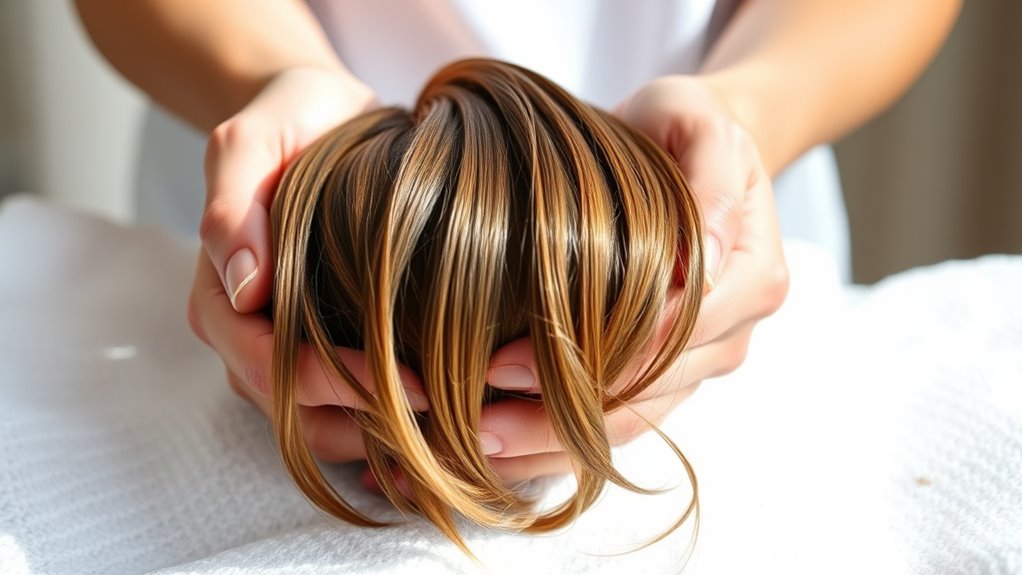Understanding hair care basics involves choosing the right products for your hair type, using gentle techniques to wash and condition, and protecting your hair from damage. Proper tools and regular trims also help keep hair healthy, shiny, and manageable. Developing a consistent routine that includes treatments and environmental protections boosts hair resilience over time. If you keep exploring, you’ll discover simple ways to truly care for your hair and achieve great results.
Key Takeaways
- Match hair care products to your specific hair type and needs, such as oily, dry, or color-treated hair.
- Use gentle, sulfate-free shampoos and proper conditioning to maintain scalp health and hair moisture.
- Incorporate regular treatments like masks and trims to prevent damage, split ends, and promote growth.
- Protect hair from environmental damage by using UV filters, heat protectants, and avoiding excessive heat styling.
- Develop a consistent routine with suitable tools and techniques to ensure healthy, shiny, and manageable hair.
Choosing the Right Shampoo for Your Hair Type
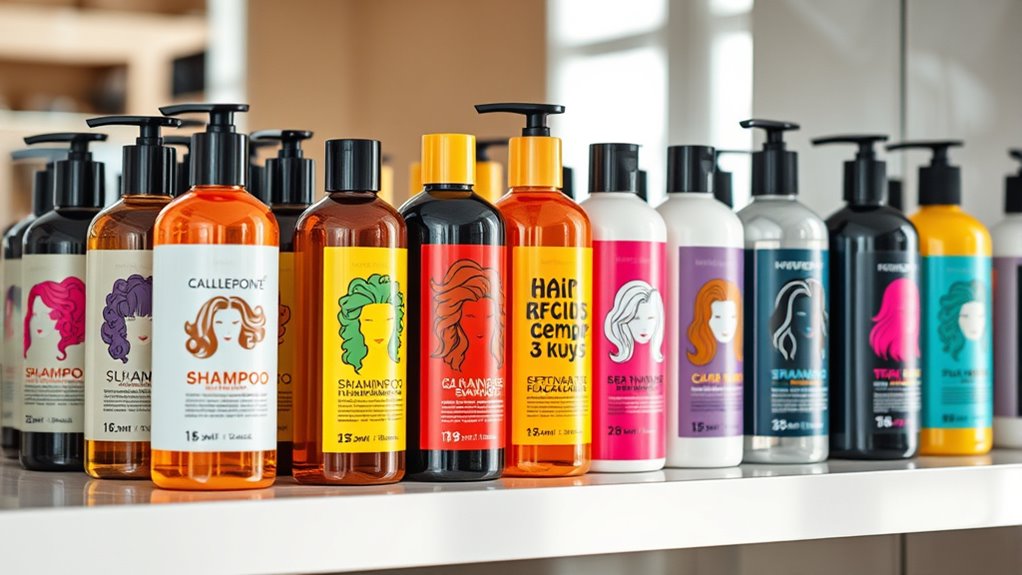
Have you ever wondered why some shampoos work better for your hair than others? The key is choosing a formula that suits your hair type and supports scalp health. If your scalp tends to be oily, look for shampoos that clarify without stripping essential oils. For dry or damaged hair, opt for moisturizing formulas that nourish from root to tip. When selecting a shampoo, don’t overlook fragrance selection; a scent that appeals to you can make your routine more enjoyable. Avoid harsh chemicals that can irritate your scalp or cause buildup. Always read labels carefully to find ingredients that match your hair’s needs. Using shampoos formulated with sustainable materials can also contribute to environmentally friendly hair care routines. By choosing the right shampoo, you’ll promote healthier hair and a balanced scalp, making your hair care routine more effective and satisfying.
The Importance of Conditioner and How to Use It

Ever wonder why conditioner is an essential step in your hair care routine? It helps restore moisture, smooths the cuticle, and reduces breakage. To maximize its benefits, consider these tips:
- Use a deep conditioning treatment weekly to repair damage and boost hydration.
- Apply conditioner mainly to mid-lengths and ends, avoiding the scalp to prevent buildup.
- Incorporate leave-in treatments after washing for added moisture, protection, and manageability.
Conditioners seal in moisture and protect strands, especially when combined with occasional deep conditioning. Leave-in treatments are perfect for extra nourishment and frizz control throughout the day. Proper use of conditioner ensures healthier, shinier hair, making it easier to style and less prone to damage.
Proper Washing Techniques to Keep Hair Healthy
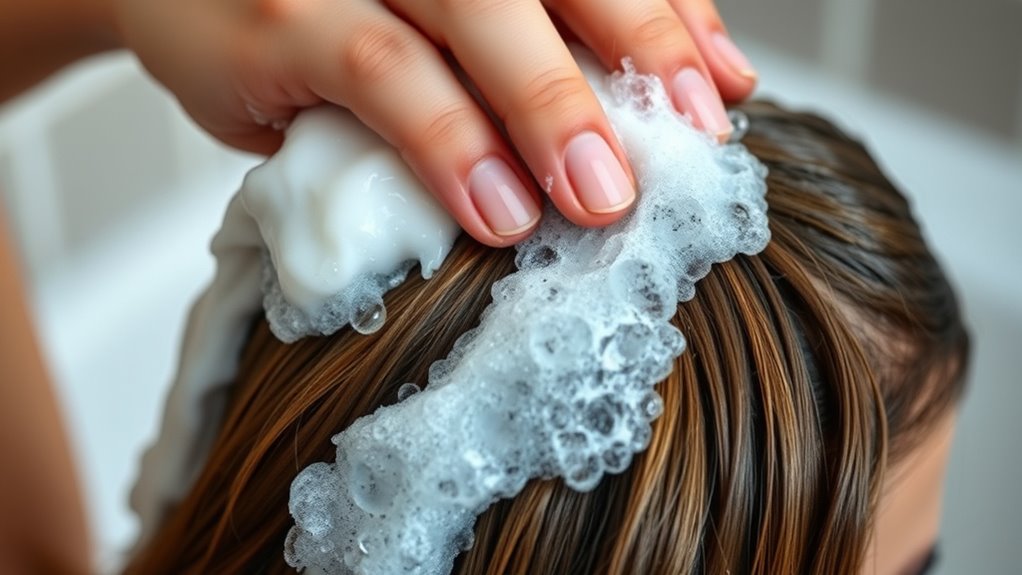
Choosing the right shampoo and washing your hair at the correct frequency are key to maintaining healthy hair. Using a gentle shampoo suited to your hair type helps prevent damage, while washing too often can strip away natural oils. Find the balance that works for you to keep your hair clean without overdoing it.
Choosing the Right Shampoo
Selecting the right shampoo is essential for maintaining healthy hair, but with so many options available, it can be overwhelming. To choose effectively, consider these factors:
- Hair Type: Pick shampoos formulated for your specific hair type, whether oily, dry, or color-treated.
- Targeted Benefits: Look for ingredients that address your needs, such as frizz control or scalp exfoliation. For instance, hydrating formulas help tame frizz, while exfoliating shampoos refresh your scalp.
- Ingredients: Opt for gentle, sulfate-free options to avoid stripping natural oils and damaging your scalp or hair.
Proper Washing Frequency
Washing your hair too often or not enough can lead to issues like dryness, oil buildup, or scalp irritation. Finding the right washing schedule is key to maintaining scalp health. If you wash too frequently, you strip natural oils, causing dryness and irritation. Conversely, washing too infrequently allows excess oil and dirt to accumulate, leading to clogged pores and scalp issues. Typically, aim to wash your hair every 2-3 days, but adjust based on your hair type and activity level. For oily scalps, more frequent washing might be necessary, while dry scalps benefit from less frequent cleansings. Pay attention to how your scalp responds and adapt your washing schedule accordingly. Consistency is essential for keeping your scalp healthy and your hair looking its best. Incorporating natural oils into your hair care routine can help maintain a healthy scalp balance and prevent over-cleaning.
The Role of Hair Masks and Treatments
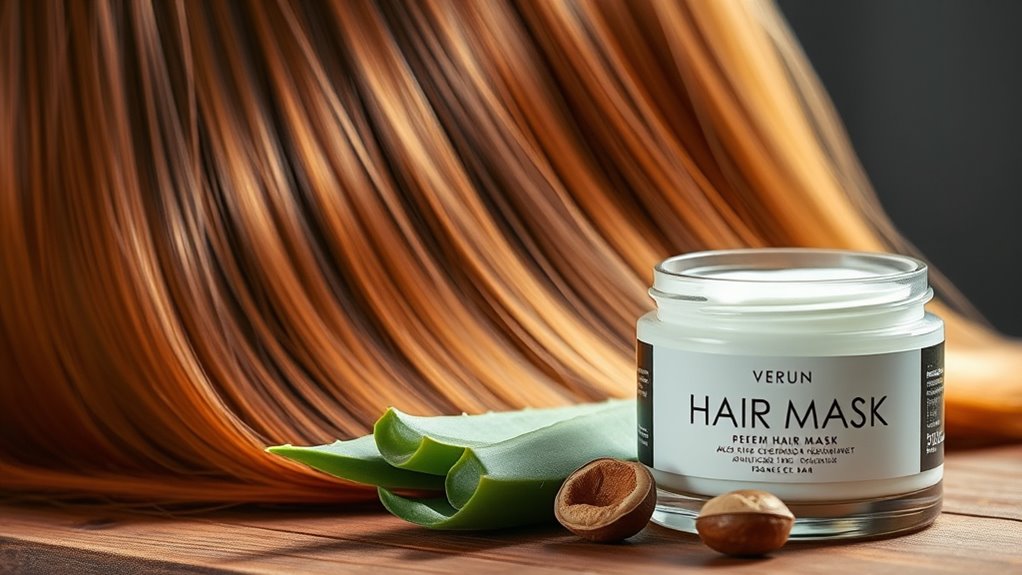
Hair masks and treatments play a crucial role in maintaining healthy, strong, and shiny hair by delivering concentrated nutrients directly to your strands. They are essential for deep conditioning and restoring moisture, especially after chemical or heat damage. When you use hair masks, you provide your hair with vital ingredients that penetrate deeply, improving elasticity and reducing breakage. To maximize benefits, consider these steps:
Deeply nourish your hair with masks to boost strength, shine, and elasticity.
- Apply a nourishing hair mask once a week for optimal results.
- Focus on mid-lengths and ends, where damage tends to accumulate.
- Leave the mask on for the recommended time to ensure deep penetration and nourishment.
- Regular use of treatments can help protect hair from damage and breakage caused by environmental factors and styling practices.
Towel Drying and Proper Brushing Methods
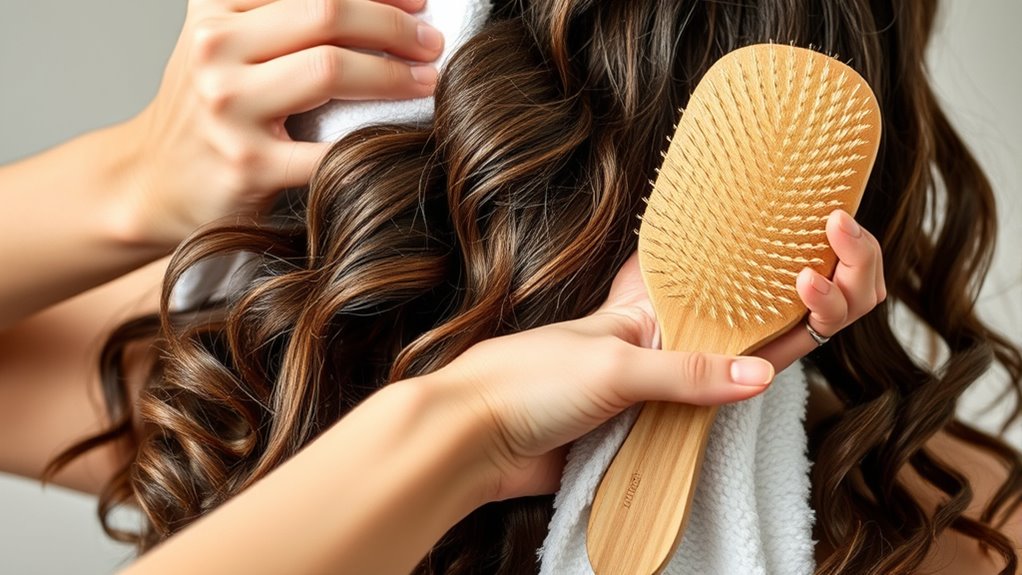
After towel-drying your hair, it’s important to handle it gently to prevent damage. Use a soft towel and employ the towel technique by patting or squeezing your hair instead of rubbing. Rubbing can cause breakage and frizz. Once your hair is mostly dry, follow a proper brushing sequence. Start at the ends, gently working your way up to the roots to minimize pulling and breakage. Use a wide-tooth comb or a brush designed for detangling, and avoid aggressive strokes. Be patient and gentle, especially with wet hair, which is more fragile. Proper towel drying combined with a gentle brushing sequence helps maintain your hair’s health, reduces split ends, and keeps your strands smooth and manageable. Additionally, choosing the right brush type can significantly impact your hair’s health and appearance.
Heat Styling: Tips for Minimizing Damage

To protect your hair from heat damage, always use a heat protectant spray before styling. Limit how often you use hot tools and choose gentle, ceramic or tourmaline tools to reduce stress on your strands. These simple steps can help keep your hair healthy even with regular heat styling. Additionally, maintaining proper bedroom environment can contribute to overall hair health, as good sleep habits and a calm space support better hair condition.
Use Heat Protectants
Using heat protectants is essential for minimizing damage when you style your hair with hot tools. They provide crucial thermal protection, shielding your strands from the intense heat of curling irons, straighteners, and blow dryers. To maximize their effectiveness, follow these steps:
- Apply heat protectant evenly to damp or dry hair, ensuring full coverage.
- Wait a few minutes for the product to absorb before applying heat.
- Use the lowest heat setting necessary for your style to reduce unnecessary stress on your hair.
Limit Heat Frequency
Limiting how often you heat style your hair is one of the most effective ways to prevent damage. Excessive thermal styling can cause heat damage, weakening strands and leading to breakage. To visualize, imagine this table:
| Low | Moderate | High |
|---|---|---|
| Twice a week | Every 3 days | Daily use |
| Gentle tools | Medium heat | High heat |
| Occasional touch-ups | Regular styling | Frequent styling |
Reducing heat exposure prevents weakening of your hair’s structure. Use thermal styling sparingly, and always opt for lower temperatures when you do heat style. This approach minimizes damage and maintains healthy hair, helping you achieve style without sacrificing strength. Remember, less is more—your hair will thank you for giving it a break from frequent heat. Incorporating sustainable materials into your hair care routine can also support healthier hair and scalp over time.
Opt for Gentle Tools
Choosing the right styling tools can make a significant difference in maintaining your hair’s health. Using gentle tools minimizes damage and preserves your hair’s natural shine. To protect your scalp and strands, consider these tips:
- Select tools with soft bristle brushes, which distribute pressure evenly and reduce breakage.
- Use ceramic or tourmaline curling irons and flat irons, as they generate less heat and distribute it more evenly.
- Always opt for tools with adjustable temperature settings, so you can keep heat levels low, especially if you have a gentle scalp or fine hair.
- Additionally, choosing best hot rollers for long hair can help achieve glamorous curls with minimal effort while reducing heat damage.
Protecting Hair From Environmental Factors
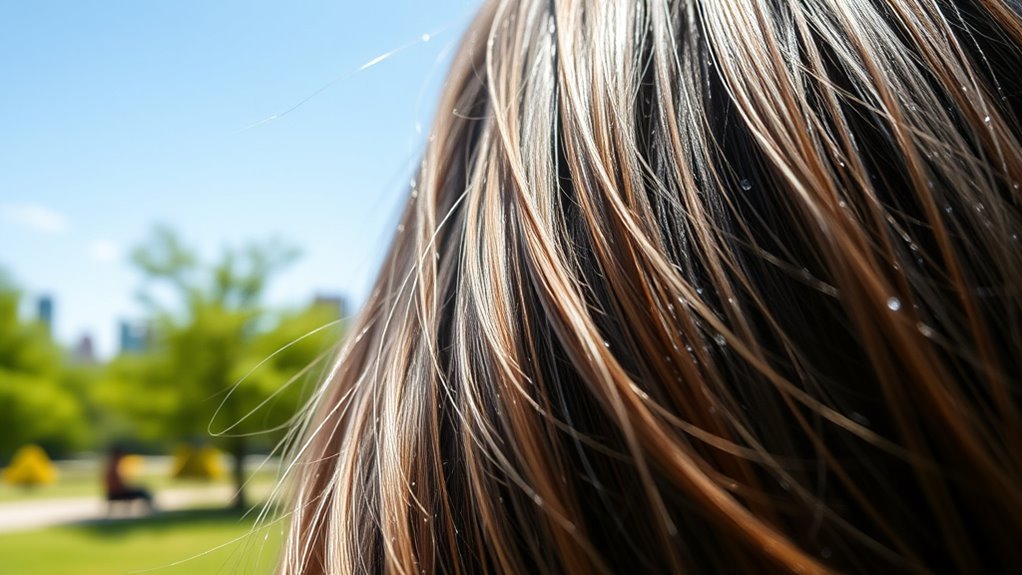
Environmental factors like sun exposure, wind, and pollution can considerably damage your hair if you don’t take steps to protect it. To combat this, start with sun protection—wear hats or use products with UV filters to shield your strands from harmful rays. Pollution barriers are also essential; look for leave-in conditioners or serums that form a protective layer, preventing pollutants from settling on your hair and scalp. Regularly washing with gentle, clarifying shampoos helps remove buildup caused by environmental pollutants. Additionally, avoid excessive heat styling, which can weaken hair already stressed by environmental damage. By incorporating these measures into your routine, you’ll help maintain healthier, stronger hair despite outdoor challenges. Protecting your hair from environmental factors is key to preserving its natural shine and resilience.
Regular Trims and Their Benefits

Regular trims are essential for maintaining healthy, vibrant hair. They help prevent split ends from traveling up the hair shaft, which can cause breakage and dullness. By trimming regularly, you support better hair growth and maintain a neat appearance. Consider these benefits:
- Reduces split ends, keeping hair looking smooth and healthy
- Promotes hair growth by preventing damage from split ends and breakage
- Enhances overall hair texture and manageability
- Using the right filtering technology can further improve hair health by removing environmental pollutants and excess oils that can damage hair.
Skipping trims allows split ends to worsen, leading to more damage and slower growth. Regular trims remove damaged strands and encourage your hair to grow stronger. They also improve your hair’s overall appearance, making it easier to style and maintain. Staying consistent with trims guarantees your hair stays vibrant, healthy, and resilient.
Developing a Consistent Hair Care Routine
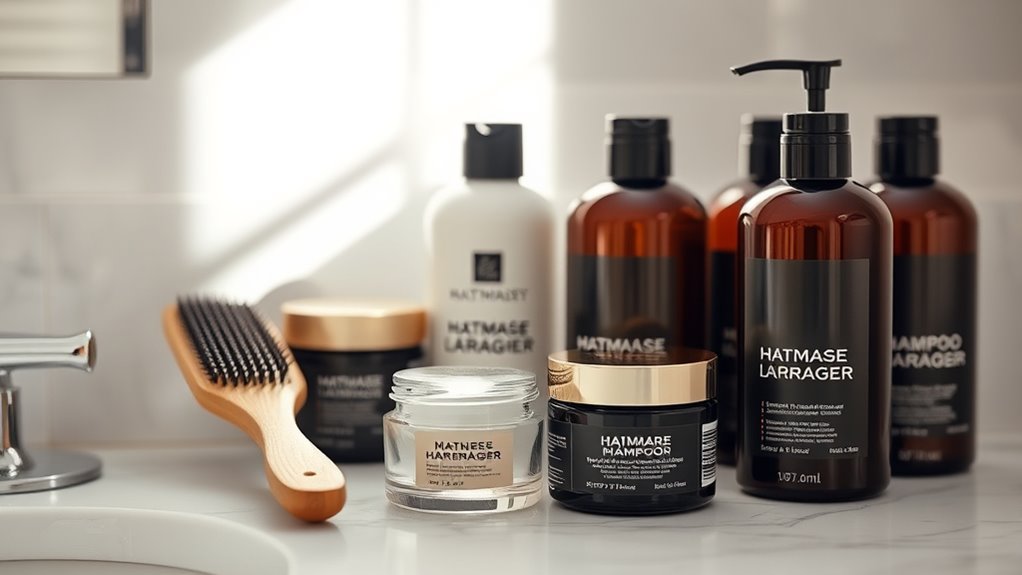
Developing a consistent hair care routine is key to maintaining healthy, beautiful hair. Your routine should match your hair texture, whether it’s straight, wavy, curly, or coarse. Consistency helps balance scalp health by removing buildup and preventing dryness or oiliness. Use gentle shampoos suited for your scalp type and avoid over-washing, which can strip natural oils. Incorporate regular conditioning to keep hair moisturized and manageable. Don’t forget to apply treatments or oils tailored to your hair’s needs. Establishing regular washing, conditioning, and styling habits ensures your scalp stays healthy, promoting stronger, shinier hair. Over time, this routine becomes second nature, helping you achieve and maintain the hair look you desire while supporting overall scalp health. Additionally, understanding the importance of scalp health can help you tailor your routine for optimal results.
Frequently Asked Questions
How Often Should I Wash My Hair for Optimal Health?
Your hair washing frequency depends on your hair type and scalp health. If you have oily hair or scalp issues, washing every 2-3 days helps keep your scalp clean and balanced. For dry or curly hair, washing once a week or less prevents dryness and damage. Pay attention to your scalp’s signals, and adjust accordingly. Regular but not excessive washing maintains scalp health and keeps your hair looking its best.
Can Hair Care Products Cause Allergic Reactions?
Hair care products can cause allergic reactions if you have chemical sensitivities or ingredient allergies. You might experience itching, redness, or swelling after using certain shampoos, conditioners, or styling products. Always check ingredient labels and do a patch test before trying new items. If you notice any adverse reactions, stop use immediately and consult a dermatologist. Being aware of your sensitivities helps prevent uncomfortable or harmful allergic responses.
What Ingredients Should I Avoid in Hair Products?
Avoid ingredients that cause concern, like parabens, sulfates, and phthalates, which can trigger ingredient sensitivities or harmful chemical reactions. These harsh chemicals can irritate your scalp or damage your hair. Be vigilant about product labels and steer clear of synthetic scents or dyes. By reading labels carefully, you protect your hair’s health and prevent allergic reactions, ensuring your hair care routine remains safe, simple, and satisfying.
How Does Diet Affect Hair Health?
Your diet plays a vital role in hair health. Nutritional deficiencies, like lacking iron, zinc, or biotin, can weaken your hair and cause thinning. Eating a balanced diet rich in vitamins and minerals supports hair strengthening and growth. Make certain you include protein, fruits, and vegetables to nourish your scalp and hair follicles. By maintaining good nutrition, you help keep your hair healthy, shiny, and strong over time.
Are Natural Remedies Effective for Hair Growth?
You might wonder if natural remedies like herbal treatments and essential oils really promote hair growth. While some people see positive results, scientific evidence is limited. Herbal treatments such as rosemary or peppermint oil can stimulate scalp circulation, and essential oils may help improve scalp health. However, consistency and patience are key; these remedies work best when combined with good hair care habits. Give them a try and see what works for you.
Conclusion
Think of your hair as a delicate garden—nurture it with the right tools and routines, and it’ll flourish with liveliness. When you choose suitable products and handle your hair gently, you’re watering a budding bloom, not tearing leaves apart. Stay consistent, protect from harsh elements, and trim away dead ends like pruning a tree. With patience and care, your hair will shine like a well-tended masterpiece, radiating health and beauty every day.
